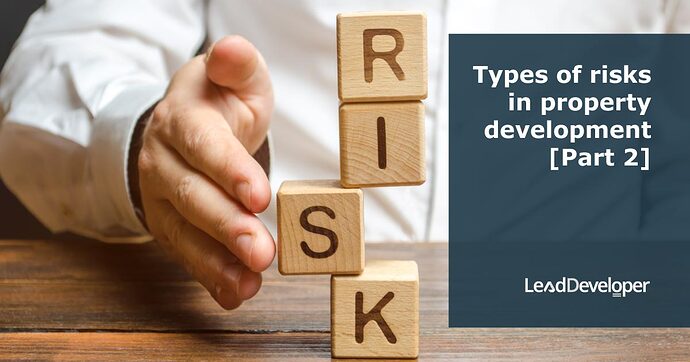Risk Management 02
This article focuses on identifying and managing various risks involved in property development, emphasizing the importance of due diligence and strategic planning. Key points include:
Due Diligence
Highlighting the risk of buying a “lemon” or a problematic property due to insufficient due diligence. Emphasizes the need for a thorough system and method in assessing potential risks to ensure repeated success.
Construction Risk
Discusses the “tripod agreement” involving the bank, borrower, and building contractor, addressing the potential for a builder going bankrupt and project failure.
Market Risks
Considers the impact of market downturns and the importance of scenario planning, especially for larger projects. Suggests using probability grids for risk assessment.
Risk Mitigation Strategies
Outlines strategies like avoiding, reducing, transferring, or retaining risk. Suggests consulting with experts, using professional indemnity, and considering joint ventures to spread risk.
Financial Planning
Advises on financial feasibility, including contingency planning, diversification, and running sensitivity analyses to prepare for variable costs and market changes.
Insights based on numbers:
- The probability of occurrence and impact of various risks are quantified, suggesting a structured approach to risk assessment.
- Emphasizes the percentage likelihood of risks and their potential impact on project outcomes, demonstrating the importance of quantitative analysis in risk management.
Frequently Asked Questions
What are the most common pitfalls in property development risk management?
A significant pitfall is the lack of a systematic approach to risk assessment and management. The video highlights the importance of identifying the probability of occurrence of various risks and preparing for them through scenario planning.
For larger projects, it’s especially important to undertake a detailed risk assessment, including financial feasibility studies, sensitivity analyses, and considering the potential impact of market changes.
What are the key components of a successful risk mitigation strategy in property development?
Systematic Approach
Establishing a structured method for identifying and assessing risks, including thorough due diligence, is fundamental. This approach ensures that all potential risks, from construction to market dynamics, are considered and evaluated.
Risk Assessment Tools
Utilizing tools such as probability grids to assess the likelihood and impact of various risks. This quantitative analysis helps in prioritizing risks and focusing on those with the highest potential to affect the project negatively.
Expert Consultation
Engaging with industry experts, including consultants and experienced property developers, to leverage their insights and knowledge in identifying and managing risks.
Strategic Risk Mitigation Techniques
Adopting a strategic approach to risk mitigation, including avoiding, reducing, transferring, or retaining risks based on their assessment. This involves making informed decisions on whether to proceed with a project, implementing measures to minimize potential issues, or sharing risks through partnerships and joint ventures.
Financial Planning and Analysis
Conducting financial feasibility studies and sensitivity analyses to understand how changes in market conditions, costs, and other factors could impact the project. This includes planning for contingencies and diversifying investments to spread risk.
Legal and Contractual Safeguards
Utilizing legal and contractual measures to protect against risks, such as ensuring proper contractual agreements with builders and employing insurance where necessary.
Continuous Learning and Education
Investing in education and training, such as taking relevant courses (as the video itself might be part of a larger educational series), to stay informed about best practices in risk management and property development.
What is due diligence in property development?
Due diligence refers to the thorough investigation and evaluation of a property before purchase or development. It aims to identify any potential problems or “lemons” that could make the property problematic. Due diligence involves assessing various risks, such as legal, environmental, and financial issues, to ensure that the investment is sound and the likelihood of success is maximized.
Why is due diligence important in avoiding the purchase of a problematic property?
Due diligence is crucial because it helps investors and developers uncover any hidden problems with a property before finalizing the purchase. Without a thorough due diligence process, there’s a higher risk of buying a property that has significant issues, which can lead to financial losses, legal complications, and delays in development. It ensures that all aspects of the property are carefully examined to avoid unforeseen challenges.
What is a tripod agreement in construction?
A tripod agreement is a contractual arrangement involving three parties: the bank, the borrower (or property developer), and the building contractor. This agreement outlines the responsibilities and expectations of each party in the construction process, including financing, building, and repayment terms. It aims to protect all parties involved, especially in cases where there’s a risk of the builder going bankrupt or the project failing.
How can market downturns affect property development projects?
Market downturns can significantly impact property development projects by reducing demand for property, lowering property values, and making it harder to secure financing. These conditions can lead to financial strain on developers, difficulty in selling or renting properties, and potential project failure. Scenario planning and probability grids can help developers assess and prepare for these market risks.
What are some risk mitigation strategies in property development?
Risk mitigation strategies in property development include avoiding, reducing, transferring, or retaining risk. Developers can avoid risk by not pursuing certain projects, reduce risk through careful planning and due diligence, transfer risk by using insurance or professional indemnity, and retain risk when it’s manageable or the cost of mitigation is too high. Consulting with experts and considering joint ventures are also effective strategies to spread and manage risk.
Why is financial planning important in property development?
Financial planning is vital because it helps developers assess the feasibility of a project, prepare for variable costs, and plan for market changes. It includes creating a budget with contingency funds, diversifying investments to spread risk, and running sensitivity analyses to understand how different scenarios might affect the project’s finances. Effective financial planning enables developers to navigate uncertainties and ensure the project’s success.
What role do numbers play in risk management for property development?
Numbers, or quantitative analysis, play a crucial role in risk management by providing a structured way to assess the probability of occurrence and impact of various risks. By quantifying risks, developers can prioritize which risks need more attention and resources, making the management process more efficient. This approach also helps in scenario planning, where developers can use probability grids to assess the likelihood and potential impact of different risks on project outcomes.
Test Your Knowledge
Multiple Choice Questions on Risk Management in Property Development
1. What is the primary purpose of conducting due diligence in property development?
A. To negotiate a lower purchase price.
B. To identify potential risks and problems with a property before purchase.
C. To speed up the development process.
D. To fulfill legal requirements only.
2. What does a tripod agreement in construction involve?
A. An agreement between the developer, the city, and the residents.
B. An agreement between the bank, the borrower, and the building contractor.
C. A partnership between three construction companies.
D. A contract involving the developer, architect, and project manager.
3. How can market downturns affect property development projects?
A. By increasing the speed of construction.
B. By raising the interest rates on loans.
C. By reducing demand for property and affecting project feasibility.
D. By increasing the availability of construction materials.
4. Which of the following is NOT a risk mitigation strategy mentioned in the article?
A. Avoiding risky projects altogether.
B. Increasing the project budget to cover all potential risks.
C. Transferring risk through insurance.
D. Consulting with experts to make informed decisions.
5. Why is financial planning considered important in property development?
A. It guarantees a high return on investment.
B. It enables developers to avoid paying taxes.
C. It helps in assessing project feasibility and preparing for market changes.
D. It ensures that the project will be completed ahead of schedule.
6. In risk management for property development, how are the probability of occurrence and impact of various risks utilized?
A. To determine the color scheme of the development.
B. To prioritize which risks to address based on their potential impact.
C. To decide which construction materials to use.
D. To calculate the exact completion date of the project.
7. Scenario planning and the use of probability grids are recommended for:
A. Deciding on the project’s marketing strategy.
B. Assessing the impact of market downturns on larger projects.
C. Choosing the right construction equipment.
D. Hiring construction personnel.
Answers:
- B. To identify potential risks and problems with a property before purchase.
- B. An agreement between the bank, the borrower, and the building contractor.
- C. By reducing demand for property and affecting project feasibility.
- B. Increasing the project budget to cover all potential risks.
- C. It helps in assessing project feasibility and preparing for market changes.
- B. To prioritize which risks to address based on their potential impact.
- B. Assessing the impact of market downturns on larger projects.
Assignment
Practical Exercise: Risk Management in Property Development
Objective:
This exercise aims to deepen your understanding of risk management strategies in property development, emphasizing due diligence, construction risks, market risks, risk mitigation strategies, and financial planning.
Instructions:
You will be conducting a mock risk assessment on a hypothetical property development project. Your tasks will include identifying potential risks, evaluating the impact of these risks, proposing mitigation strategies, and conducting a basic financial analysis to ensure the project’s feasibility.
Part 1: Due Diligence Exercise
To Do:
- Choose a location for a hypothetical property development project (e.g., residential complex, commercial building).
- List at least five potential risks associated with the property/location that due diligence might uncover (consider environmental, legal, and market factors).
- Propose a method for assessing each risk you’ve identified.
Research Question:
- What are common due diligence practices in property development, and how do they mitigate the risk of investing in a problematic property?
Part 2: Construction Risk and Mitigation
To Do:
- Imagine a scenario where the chosen property development faces a significant construction risk (e.g., the bankruptcy of a building contractor). Describe the scenario in detail.
- Draft a simplified version of a “tripod agreement” that could protect the development project in the scenario you described.
Research Question:
- How do real-world property development projects manage the risk of construction delays or contractor bankruptcy?
Part 3: Market Risk Analysis
To Do:
- Create a basic probability grid for your project, considering at least three major market risks (e.g., economic downturn, change in consumer preference, new regulations).
- For each risk, assess its probability (low, medium, high) and potential impact on the project (low, medium, high).
Research Question:
- Find a real-world example of a property development project that was impacted by market risks. How were these risks managed?
Part 4: Risk Mitigation Strategies
To Do:
- Based on the risks you’ve identified in Parts 1-3, propose at least one strategy for avoiding, reducing, transferring, or retaining each risk.
- Identify which experts you might consult to help mitigate these risks.
Research Question:
- What are some innovative risk mitigation strategies used in the property development industry?
Part 5: Financial Planning
To Do:
- Outline a basic financial plan for your hypothetical project, including budget estimates, contingency funds, and a diversification strategy.
- Conduct a simple sensitivity analysis to understand how changes in costs or market conditions could affect your project’s financial feasibility.
Research Question:
- How do successful property development companies use financial planning to navigate uncertainty in project costs and market conditions?
Submission Guidelines:
- Compile your findings and analyses into a comprehensive report.
- Include any assumptions you’ve made about your hypothetical project.
- Cite any external sources you’ve consulted for research questions.
- Submit your report via mail or comments.

![Types of risks in property development [Part 2]](https://edge.leaddeveloper.com/uploads/db5494/original/2X/d/d1ef51ea098a887e34338ff800be687920571e50.jpeg)

